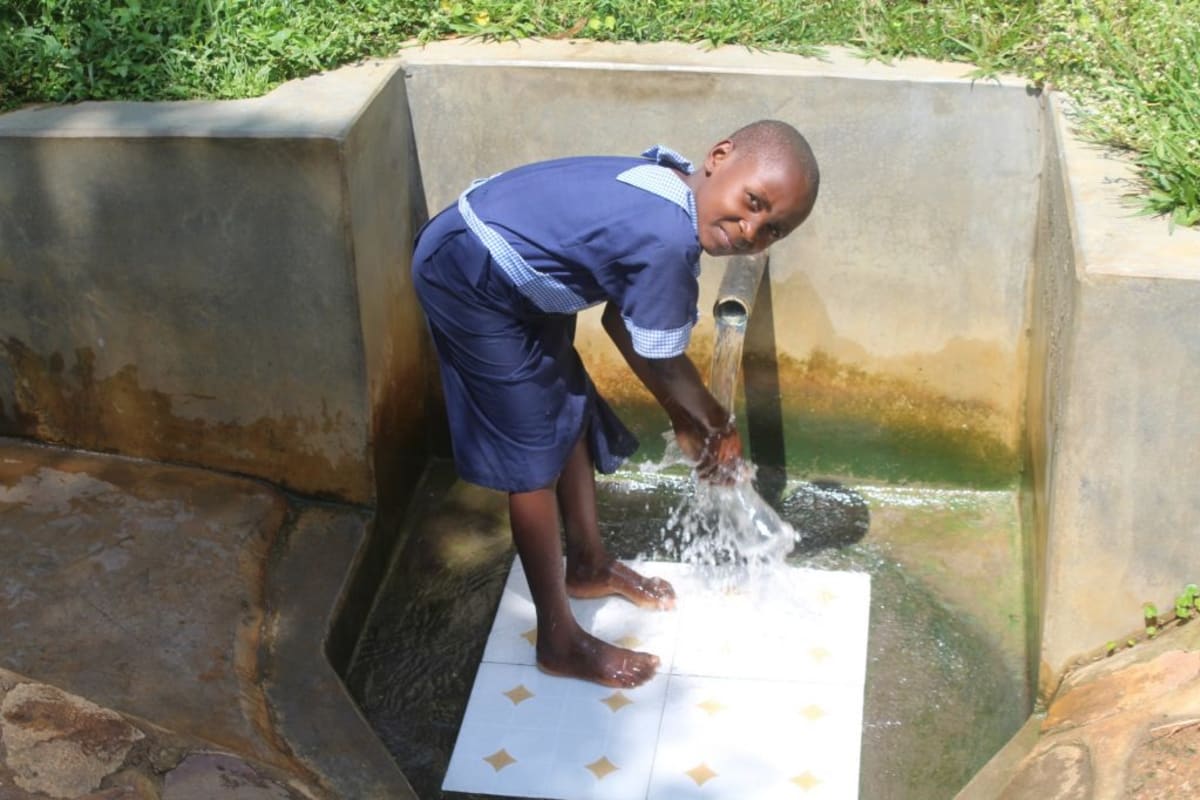Please note: original photos were taken before the COVID-19 pandemic.
"Sometimes we find the cows drinking directly from the spring; you are forced to wait for the water to settle before using it. This is always time-consuming on my end. You are forced to forego some activities to come and fetch water before it gets contaminated," said Celestine Mutembete, a 32-year-old farmer in Mahola.
Serving 210 people, Oyula Spring has always had plenty of water, but it has never been safe for drinking. In its unprotected state, Oyula Spring is open to various kinds of contamination. Community members spend a lot of time clearing off what they can of the spring's algae, only to collect water already contaminated from animal feces and surface runoff. The runoff carries toxins from farm chemicals and household waste. People also step into the water due to the slippery and muddy area, either by accident or simply because of the best footing needed to try to catch the cleanest water. Their feet and shoes further contaminate the water.
Overcrowding at the spring is common due to the time it takes for each person to try to clear the water, then scoop it into their containers by hand using a smaller jug. This time wastage is especially not conducive during times of the coronavirus, when community members are trying to minimize their time in public and their numbers at the water point.
Though the water source is located near community members' homes, if they leave you at home going to fetch this water, you may think they have traveled for a very long distance due to the time they are away.
The environment around this water point is dangerous to those fetching water. This is because the area around the spring is not always kept clean. This spring is not protected by something such as a fence, and this makes it vulnerable to animal access. This happens mostly when there is much sun, community members report, when wandering animals like sheep and goats will step right into the spring to drink from it.
Community members attribute frequent back pain to the deep bend they have to use to fetch water while trying to balance on stones raised just above water level. While fetching water, you need also to be very careful not to make the water dirty, since this will lead to increased illness. Community members also complain of experiencing increased rates of stomachaches whenever there is much rain, which pours more dirty surface runoff into the spring's collection area.
Other negative consequences of having to rely on the dirty spring water are how it delays schedules and leads to conflict between community members. Having to wait for the water to clear between water users means adults and children alike waste a lot of time at the spring. This disrupts schedules both in the morning and evening as students get to school late and parents get a late start to their work and meal preparation.
"I am always forced to wake up very early in the morning to come and fetch water which we use to pour in our pots for drinking. When you get here, you might find several other people who woke up before you, so you wait for them to finish fetching. This makes me get to school late. The teachers do not understand this and punish me for coming late," said primary school student Ronald.
Though the water becomes dirty each time someone fetches from the spring, the next person fetching it always accuses the first of having done it intentionally. This leads to disagreements among spring users.
Many people have come to this area promising to help Mahola communtiy members protect their spring. But those who come, village leaders say, make empty promises and leave without ever helping them. Many people had lost hope of ever accessing safe and clean water. Now, all of that is about to change.
What We Can Do:
Spring Protection
Protecting the spring will help provide access to cleaner and safer water and reduce the time people have to spend to fetch it. Construction will keep surface runoff and other contaminants out of the water. With the community’s high involvement in the process, there should be a good sense of responsibility and ownership for the new clean water source.
Fetching water is a task predominantly carried out by women and young girls. Protecting the spring and offering training and support will, therefore, help empower the female members of the community by freeing up more of their time and energy to engage and invest in income-generating activities and their education.
Training on Health, Hygiene, COVID-19, and More
To hold trainings during the pandemic, we work closely with both community leaders and the local government to approve small groups to attend training. We ask community leaders to invite a select yet representative group of people to attend training who will then act as ambassadors to the rest of the community to share what they learn. We also communicate our expectations of physical distancing and wearing masks for all who choose to attend.
The training will focus on improved hygiene, health, and sanitation habits in this community. We will also have a dedicated session on COVID-19 symptoms, transmission routes, and prevention best practices.
With the community’s input, we will identify key leverage points where they can alter their practices at the personal, household, and community levels to affect change. This training will help to ensure participants have the knowledge they need about healthy practices and their importance to make the most of their water point as soon as water is flowing.
Our team of facilitators will use a variety of methods to train community members. Some of these methods include participatory hygiene and sanitation transformation, asset-based community development, group discussions, handouts, and demonstrations at the spring.
One of the most important issues we plan to cover is the handling, storage, and treatment of water. Having a clean water source will be extremely helpful, but it is useless if water gets contaminated by the time it is consumed. We and the community strongly believe that all of these components will work together to improve living standards here, which will help to unlock the potential for these community members to live better, healthier lives.
We will then conduct a small series of follow-up trainings before transitioning to our regularly scheduled support visits throughout the year.
Training will result in the formation of a water user committee, elected by their peers, that will oversee the operations and maintenance of the spring. The committee will enforce proper behavior around the spring and delegate tasks that will help preserve the site, such as building a fence and digging proper drainage channels. The fence will keep out destructive animals and unwanted waste, and the drainage will keep the area’s mosquito population at a minimum.
Sanitation Platforms
At the end of training, participants will select 5 families that should benefit from new concrete latrine floors called sanitation platforms. Training will inform the community and selected families on what they need to contribute to make this project a success. They must mobilize locally available materials, including bricks, clean sand, and gravel. The 5 families chosen for sanitation platforms must prepare by sinking a pit for the sanitation platforms to be placed over.
All community members must work together to make sure that accommodations and food are always provided for the work teams. The families will then be asked to complete their latrines by constructing a superstructure over their platforms. These 5 sanitation platforms will then serve as examples for the rest of the community to replicate.

 Protected Spring
Protected Spring
 Rehabilitation Project
Rehabilitation Project


















































